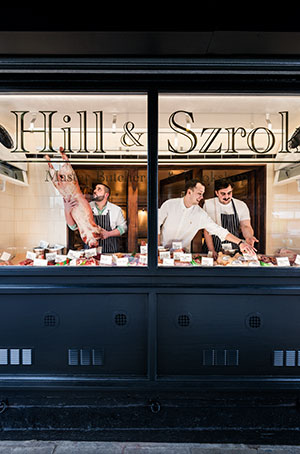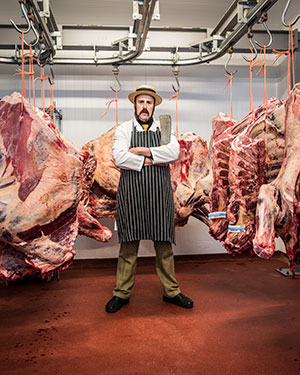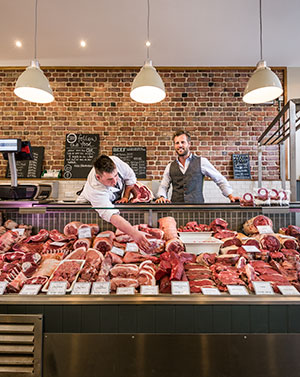A new breed of butcher

Simply sign up to the Life & Arts myFT Digest -- delivered directly to your inbox.
Two and a half years ago, in the depths of Britain’s economic malaise, Malcolm Pyne bet the farm. The 43-year-old butcher leased out the shop his parents had opened in 1984 in the Somerset village of North Petherton to a funeral director and moved to a £1.5m outlet a dozen times bigger, closer to the M5 motorway for the passing trade. Then he set about selling an awful lot of meat.
“Thirty pigs a week; 20 lambs; we kill six bullocks and then buy cuts so it’s probably 10. We sell masses of chicken, between 1,200 and 1,500 breasts a week. It’s no good holding back if that’s the trend. Of course, we sell them as Cajun chicken, or with coriander, or chicken Kiev, not just chicken. If I woke up one morning and became a traditional butcher, I’d knock 80 per cent off my volume,” he says.
Given the chronic troubles of the trade in the past four decades, as farms suffered, small abattoirs closed, supermarkets took trade, and thousands of butchers surrendered, it was a stretch. Yet Pyne’s of Somerset is doing nicely, serving more than 500 shoppers on Saturdays. “I’m happy to stand here and say I’m a capitalist. This industry used to be everyone working all the hours God sent for a pittance. I’ve just bought myself a spanking-new Range Rover. The days of playing at it are gone.”
At the same time, 38 miles away, Adam Denton opened a butcher’s shop called Ruby & White in the Clifton district of Bristol, next to his restaurant, Cowshed. It has done so well that he is opening a second in Bath. Denton has a similarly businesslike view. “The fifth-generation butcher might have half-decent meat but it is outdated. If it looks appealing, a discerning customer will desire it.
“When they come into my shop, they see solid oak doors, a slate floor all the way through, and tongue and groove panelling. There is Farrow & Ball paint and some sexy staff with a meat display to die for. They tell me: ‘Sainsbury is charging £27 a kilo and you charge £35 but you’ve chopped it up, wrapped it nicely and told me how to cook it.’”
The revival of the butcher defies conventional wisdom. The story of the UK high street in the supermarket era is one of relentless decline, with independents unable to pay high rates and rents and match the supply-chain efficiencies of big businesses. The New Economics Foundation think-tank declared “the death of small shops” in 2010. Of 22,000 butcher’s shops in the UK in the mid-1990s, fewer than a third – 7,100 – were still in business by 2010, according to Meat Trades Journal.
Butchers were hammered by a series of crises – notably BSE in the late 1990s, which led to British beef being banned in many countries and the sale of beef on the bone being limited. In 2006, Dewhurst, the biggest UK chain of butchers, went into administration. “There was a massive loss of trust in the meat trade, coupled with the rising power of supermarkets. Shoppers went there instead because they trusted their brands,” says Ed Bedington, the Journal’s editor.
But something is stirring on the British high street. For the first time in decades, supermarkets are struggling to adjust to changes in shoppers’ habits, including the rise of discounters such as Aldi, while independent shops show signs of life. “Food is the centre of the high street and the butcher is the centre of food,” says Andrew Sharp, a Yorkshire butcher and industry consultant. “I’m sorting out Selfridges’ meat department at the moment,” he adds.

The seeds of the revival were sown in the early 2000s, when shoppers had enough cash to follow the advice of celebrity chefs such as Jamie Oliver and Nigella Lawson. “It is essential to get good beef from a butcher you trust,” Lawson declared in her book How to Eat in 1998, discussing the crisis of confidence that followed the BSE crisis. “I go to Mr Lidgate in west London and I know that the beef I get from him comes from organic and suckler herds.”
The first butchers to benefit from such promotion were those in wealthier districts of London and the southeast, such as C Lidgate of Notting Hill and Allens of Mayfair. The Ginger Pig, which started as a Borough Market stall for meat reared by Tim Wilson, a North Yorkshire farmer, now operates five shops. They are outlets for the style- and health-conscious middle classes, shopping in the old-fashioned way.
These shops are reminiscent of the butchers of the first half of the 20th century – they buy directly from farmers and take pride in using the entire animal for a wide variety of cuts, as well as bacon and sausages. Many now go further, serving meat with sauces and vegetables ready to be cooked by time-pressed customers. They have adapted the ready-made meal, in a fresher form.
“We buy meat in a traditional manner. The modern bit is how we prepare it,” says Brindon Addy, a butcher in Holmfirth, West Yorkshire and the chairman of the Q Guild of independent butchers. “Now it is fancy tiling, and ready-to-cook. People have less time now – they take something home to put in the oven while they bathe the kids. The old-style butcher never cooked in his life. We are as much chefs as butchers.”
The 2008 downturn turned out to affect supermarkets more than the new breed of butchers. Shoppers had become used to going to Tesco or Sainsbury’s and filling a trolley with food, not caring if a few items spoiled by Friday. As wages were squeezed, they spent more at discount stores and less at supermarkets, buying more often from convenience stores and independents.
“People want to waste less, so they have to top up more,” says Simon Twigger, the head of Sainsbury’s 600 Local stores. The group is now opening one or two Locals a week in response and Twigger insists that his shops coexist happily with independent butchers. “I cannot take in a lamb carcass and cut it and bone it the way that a specialist can but if someone wants chicken or mince at 11pm, they will get it from me at a good price.”
A survey in January by IGD, the retail research group, found that 28 per cent of people said they were shopping more at specialists such as butchers and grocers and another 11 per cent intended to do so. “The trend is towards shopping little and often,” says David Shukri, a channel research manager there. The number of butchers has fallen slightly since 2010 – to 6,500 in 2013, according to The Grocer magazine’s Grocery Retail Structure survey – but that number masks a rise in quality.
The newcomers include a generation of butchers who grew up with the British food revival and regard the business quite differently. The contrast in approach is evident on Broadway Market, a street market in Hackney, east London, which has transformed in the past decade from being an old-fashioned, blighted parade with boarded-up shops to a magnet for young professionals.
Henry Tidiman, a butcher who had traded on Broadway Market for more than 50 years, closed his shop earlier this year, partly prompted by a sharp rise in rent. It was quickly replaced on the other side of the road by Hill & Szrok, a “Master Butcher & Cookshop” started by Luca Mathiszig-Lee, a 24-year-old entrepreneur who trained at The Eagle gastropub in Clerkenwell and then opened The Three Crowns, a pub and restaurant in Shoreditch.

“Regardless of what meat it sold, your hipster would not go into that shop because it was an old-school butcher,” Mathiszig-Lee says of Tidiman’s. “They would be put off because it wasn’t uber-traditional – it was there for a function, with little bits of plastic grass on the displays. Our idea is to take the best bits from a traditional butcher, with marble and wood, but do it clean and nice and cool.”
Mathiszig-Lee knows what some customers will make of that. “I had a couple of old ladies walk past the other day. I told them what we were doing and they said: ‘Oh, it’s not going to be a yuppie butcher’s, is it? You’ll still give us discounts on Wednesdays?’ We would never want to price out the locals and open a place that was super-expensive. That would be harsh.”
Yet low-margin butchery, competing with supermarkets, is a path to nowhere. His twist – drawn from the “cookshops” of 17th-century London – is to be a butcher’s by day and a grill by night, where people can choose a cut of meat and then have it cooked for them. “Open kitchens [in restaurants] give you the trust in what you are eating. A butcher’s is the next progression.”
Like others, Hill & Szrok exploits the theatre of the butchery trade, putting meat in a refrigerated window display. Tom Richardson Hill, a 25-year-old butcher who trained at Allens of Mayfair, cuts on an open marble counter and the cook is Alex Szrok, a chef from The Eagle. “You will get exactly the cut you want and you can talk to the butcher, instead of picking it off a shelf,” he says.
The emphasis on buying meat from farms was rewarded in last year’s horsemeat scandal, when mince was found to have been adulterated. Unlike the BSE crisis, this hurt supermarkets and helped butchers. “I know a butcher in Barrow-in-Furness whose sales went up 40 per cent,” says Andrew Sharp. “I was born in Barrow-in-Furness and it is not exactly the centre of culture and the intelligentsia. Every time you go up 40, you keep 10.”
These butchers also buy rare breeds, such as Longhorn, shunned by supermarkets because of its fattier meat. “I drive to farms and knock on the door and introduce myself and they think I am a bit mad,” says Adam Denton of Ruby & White. “We stand in a field and discuss the cows, and I pick five I want. As the carcass dries, the moisture comes out of the fat and seals it, so the meat flakes off the bone.”
Good meat is expensive – the wholesale price of a high-quality bullock has more than doubled over a decade to reach about £1,500. The profitability of the trade, and a butcher’s ability to compete with supermarkets, depends upon making the most of it. “It’s crucial to sell the best thing to the last thing,” says Malcolm Pyne. “Anyone can sell steak. A butcher has to sell it all.”
This means persuading customers to buy lesser-known cuts of meat such as onglet, rather than just rump. The personal touch helps, and Mathiszig-Lee hopes those who eat in his cookshop will take a similar cut home. It does not hurt that more obscure cuts are often cheaper. “Someone asked me about Mouse Ear [the top of a bullock’s hindquarter shin] the other day,” says Sharp. “I know a lot about this job but I had to google that one.”
Butchers can boost margins by preparing meals as well as cutting meat. Pyne cites legs of chicken, which he can buy for 60p wholesale and sell for £1.95 once his staff have boned and filled them with stuffing and bacon. That appeals to Denton’s typical shopper: “A 28 to 42-year-old woman with a young child and a teenager, rushing home to cook before picking the other one up from school.”
Even so, butchery can be a precarious business – a number of these entrepreneurs operate shops as an adjunct to a restaurant or a meat wholesaling business. James George and Richard Turner, partners in the East London Steak Company, an online delivery business, took over M&R Meats, a 19th-century shop in Clerkenwell, in November. Turner is also executive chef of Hawksmoor, the London chain of steak restaurants.
Mathiszig-Lee had spotted M&R Meats as he cycled past on the way to The Eagle. “It was open Tuesday to Friday in the daytime, never any other time. It was such a nice site and I wondered: ‘Why is it never open?’” The answer was that it was occupied by two former traders at Smithfield meat market, who supplied meat to restaurants. They arrived daily at 4am to prepare it and sent it out in vans at 9am. The shop was only an afterthought.
“I always had a soft spot for it, and saw the opportunity for what could be done if we showed it a bit of love,” George says of the pretty corner shop, with its tiled façade. “A lot of our customers kept saying: ‘Why don’t you open a shop? We want to see you.’ It’s not really a high footfall area but I think the Islington vibe might spread down a bit. We don’t sell three pork chops for the price of two but if someone wants a nice bit of beef for a family meal, that’s us.”
To comment on this article please post below, or email magazineletters@ft.com
——————————————-
Flame grilled beef wing rib with oak leaf lettuce, apple and carrot
Recipe by Alex Szrok
Serves 2
1 800+g wing rib steak on the bone
Maldon salt
Cracked black pepper
Extra-virgin olive oil
1 washed oak leaf lettuce
1 washed Braeburn apple
1 scrubbed carrot
1 dsp whole-grain mustard
Malt vinegar
Extra-virgin olive oil
Salt, pepper, sugar
● First, make the salad dressing. In a jug, pour 100ml of good extra-virgin olive oil, add the mustard and a small splash of vinegar to start. Whisk until emulsified, taste, add vinegar to your liking. I like it squintingly acidic. Balance with sugar if needed, season and then taste again.
● The wing rib is the rib end of the sirloin. I like them thick, heavily marbled, on the bone, room temperature and patted dry.
● Get your grill smoking hot (mine is a gas indoor flame grill but it could be a charcoal or gas barbecue or even a griddle pan). On a plate pour some olive oil, scatter a little salt and pepper, dredge the steak in this, then put on the hottest part of the grill. Grill hard and fast, really charred outside, blue to rare inside – if you like your steak well done, make a casserole. Turn the steak three times to get even charring and to crisp the fat. Once blackened to your liking, move to a cooler part of the grill for a few moments, then take off the heat to rest on a plate, season again with more salt and pepper and leave for at least as long as you cooked it.
● Tear the oak leaf, finely slice the apple, with a speed peeler turn the carrot into ribbons, mix in a large bowl and dress the salad.
● Cut the main muscle of the steak off the bone and slice across the grain, pour the collected meat juices over. Serve with a bottle of Graves and some bread to mop the meat juices.
——————————————-
Pork & lamb’s liver pate with sage and sherry
Recipe by Alex Szrok
Serves 10
200g lamb’s liver trimmed and sliced
200g pork liver trimmed and sliced
120ml sherry
175g butter
1 onion, diced
4 cloves garlic, crushed
120ml double cream
1 bunch sage, roughly chopped
350g skinless fatty pork belly, diced
Ground white pepper
Salt
14 rashers, smoked streaky bacon
● The flavour of this pâté is inspired by the haslet and faggots from the butcher we used as I was growing up. Heat oven to 180C. First flash fry both the types of liver hard and fast in batches until slightly crisp and brown outside but still the faintest pink inside. Pour off excess fat from the pan and deglaze with the sherry; reduce by a third. Pour this over the livers and cool. In the same pan add a bit of butter, sweat down the onion and garlic until translucent. Add this to the liver and sherry, add the cream, blitz in a food processor until smooth.
● Add the sage, the pork belly, salt to taste and 1 teaspoon ground white pepper, blitz again but maintaining the coarse texture of the pork. Line a loaf tin with the smoked bacon, pack in the pâté mix, bake in a bain marie for 1.5 hours. Let it cool then place a weight on it, a couple of tins of beans etc. Refrigerate for 12 hours. Serve with toast and your favourite pickle.
Alex Szrok is chef at Hill & Szrok, London
Comments